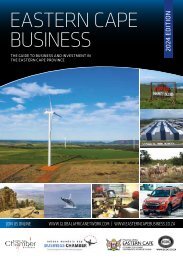Blue Chip Journal - June 2019 edition
Create successful ePaper yourself
Turn your PDF publications into a flip-book with our unique Google optimized e-Paper software.
RETIREMENT<br />
In it for the long run<br />
The life right model may be the right choice for retirement<br />
An important retirement decision<br />
is whether to remain on the<br />
property ladder or purchase a life<br />
right in a retirement development.<br />
Financial advisors would do well to consider<br />
the many benefits of the latter, argues Arthur<br />
Case, Brand Marketing Director of Evergreen<br />
Lifestyle, leading South African retirement<br />
living provider and joint venture between<br />
the Amdec Group and PSG Group.<br />
Evergreen is on a surge, expecting to<br />
grow its footprint this financial year from<br />
a total of 570 to 1200 retirement units in<br />
developments in the Western Cape and<br />
Gauteng.<br />
“The demand is there and we feel we’ve<br />
got the model right,” comments Case. “Our<br />
ambition is to grow to 10 000 units with<br />
assets of R30-billion.”<br />
This confidence is supported by current<br />
industry trends, especially a generational<br />
shift as the so-called Baby Boomers enter<br />
the retirement village market.<br />
“The oldest of them are in their early<br />
70s, and they want a lifestyle rather than a<br />
nursing model,” says Case. “They’re looking<br />
for beautiful homes and facilities, some<br />
are moving in before they finish working,<br />
and they want to enjoy a lock-up-and-go<br />
lifestyle where everything is taken care of.<br />
Older residents also require continuous<br />
care facilities.”<br />
Continuous care involves a significant<br />
investment from the developer in terms of<br />
facilities as well as keeping units operating<br />
in the early days when take-up is lower.<br />
“Few medical aids pay for frail care but<br />
they do pay for medical procedures. The<br />
smallest centres we’re building are around<br />
2 000m², with a minimum of 32 beds,<br />
and will cater for both frail and dementia<br />
care, but our bigger villages will have<br />
much bigger care centres with sub-acute<br />
facilities,” says Case.<br />
The life rights model is underpinned by<br />
the strongest property right in South Africa,<br />
as contained in the Housing Development<br />
Schemes for Retired Persons Act No 65 of<br />
1988 (HRP Act). The main benefit is that<br />
the life right developer remains involved<br />
literally for life, unlike the comparative<br />
sectional title or freehold individual title<br />
retirement village, where the developer<br />
departs once the last unit is sold.<br />
“Sectional title schemes often build frailcare<br />
centres that are not suitable and the<br />
operation and funding burden is left to the<br />
residents via their Body Corporate. In many<br />
instances these facilities are closed down or<br />
repurposed because residents do not have<br />
the resources and expertise to run these<br />
centres,” says Case.<br />
There are no transfer duties or VAT, and<br />
no special levies are permitted in terms of<br />
the Act.<br />
“Over time, a 650-unit estate is going<br />
to need investment, and that investment<br />
comes from the life right developer, never<br />
the resident. They only pay their service<br />
levy monthly,” says Case.<br />
“We continually reinvest to keep our<br />
villages pristine. During the threat of Day<br />
Zero in Cape Town, for example, we sank<br />
boreholes and installed water purification<br />
plants because we wouldn’t want our<br />
residents to queue for water.”<br />
Flexible purchase pricing is another<br />
advantage: “If you’re selling a R2-million unit<br />
with a 100% capital return on termination,<br />
you can offer it at a low purchase price and<br />
adjust the capital return at the end of the<br />
life right to accommodate a lower, more<br />
affordable purchase price.”<br />
In emergencies, residents can liberate capital<br />
from the life right capital during their<br />
tenure towards funding arrear levies or care.<br />
For middle to upper middle income<br />
South Africans, the life right model<br />
removes some of the risks of outliving their<br />
retirement capital.<br />
“Purchasers are more concerned about<br />
levy inflation and affordability than the<br />
ticket price,” says Case. “To assist, we don’t<br />
Arthur Case, Brand Marketing Director<br />
profit from levies whatsoever, nor do we<br />
charge a management fee.”<br />
Case encourages financial planners to<br />
acquire a thorough understanding of<br />
the life right model before dispensing<br />
retirement advice.<br />
“The mindset has to go beyond just<br />
preserving and growing the retirement<br />
asset – that retiring person has a range<br />
of needs. For example, many seniors will<br />
actually prejudice their retirement lifestyle<br />
in order to leave a legacy. Advisors need to<br />
be able to advise clients to look after their<br />
own retirement first – if there is a surplus at<br />
the end, then that can go to the children.”<br />
To determine which life-right retirement<br />
product is best suited to your clients' needs,<br />
Case suggests:<br />
• Look for strong shareholders, an operator<br />
with a solid track record and credentials,<br />
and scale developments – the biggest<br />
defence against levy inflation is scale.<br />
• Look for continuous care – you don’t<br />
want someone purchasing a retirement<br />
product and having to relocate seven<br />
years later when the need for care arises.<br />
• Make sure the location is right, that they<br />
don’t move away from their support<br />
networks, that they understand the pros<br />
and cons of the purchase model, and then<br />
look at affordability going forward.<br />
40 www.bluechipjournal.co.za


















